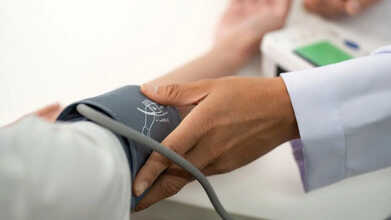- Health Conditions A-Z
- Health & Wellness
- Nutrition
- Fitness
- Health News
- Ayurveda
- Videos
- Medicine A-Z
- Parenting
What Is The Hottest Temperature A Human Body Can Handle?

Credits: Canva
As temperatures around the world rise because of climate change, the human body is increasingly confronting a little-understood and increasing hazard: excessive heat. From enduring heatwaves to sweltering heat waves with high humidity, what used to be a seasonal annoyance is now a worldwide health risk. But how hot is too hot for the human body? At what point does heat become deadly—and why?
In 2020, an article published in Science Advances identified a precise threshold by which the human body cannot survive: 95°F (35°C) wet-bulb temperature. Unlike regular temperature readings, wet-bulb temperature takes into consideration both heat and humidity. It is measured with a thermometer covered in a cloth soaked in water, replicating the way the human body dissipates heat—by evaporating sweat.
If the air surrounding the body is too moist, sweat does not evaporate. When this system breaks down, so does the body's control over internal temperature. The result? A speedy and potentially dangerous increase in core temperature.
In perspective, 115°F (46.1°C) air temperature with 30% humidity yields a wet-bulb temperature of approximately 87°F (30.5°C)—still survivable. However, a seemingly "cooler" 102°F (38.9°C) day with 77% humidity brings the wet-bulb temperature to the lethal 95°F (35°C) mark.
Once wet-bulb temperatures reach this tipping point, sweat can no longer evaporate fast enough to cool the body. Even if the skin is wet, the internal temperature continues to climb. At this stage, hyperthermia sets in—defined by a body temperature above 104°F (40°C)—leading to symptoms like confusion, rapid heart rate, organ failure, and even death.
Who’s Most at Risk?
Although no human can live above a wet-bulb temperature of 95°F, not all people are equally at risk in lower heat exposures.
- Older people, because of impaired thermoregulation.
- Obese or chronically ill people, such as those with cardiovascular disease.
- Those on certain medications, e.g., antipsychotics or beta-blockers.
- Workers outdoors and athletes, whose exertion increases body heat.
Even healthy individuals can succumb to lower wet-bulb temperatures if they are exerting themselves in direct sun or in poorly ventilated environments.
What Happens Inside the Body During Heat Exposure?
The human body contains approximately 60% water, and fluid balance is inextricably linked with temperature regulation. In hot temperatures, the body loses water quickly through sweat and respiration. If it is not replaced, dehydration occurs, causing blood volume to decrease. This affects anything from organ function to delivery of oxygen at the cellular level.
Meanwhile, the thermoregulatory system, which depends on blood flow to shuttle heat from internal organs out to the skin, starts to fail. If this cooling circuit fails, internal organs become overheated, cells start dying, and a chain of failure results in heat stroke or cardiovascular collapse.
How Hot Is Too Hot, Really?
Whereas wet-bulb temperature gives us one measurement, research indicates the ambient air temperature limit of human survival is probably between 104°F and 122°F (40°C–50°C). 122°F is at the limits of what the body can withstand while keeping its core temperature stable, says a 2021 Physiology Report.
A different approach to research implies that the temperature at which the body begins to sweat is 89.6°F (32°C)—the beginning of heat strain. Thus, danger doesn't begin at extreme temperatures only; it accumulates with time, particularly due to long exposure and high humidity.
The U.S. Environmental Protection Agency (EPA) has documented that heat directly caused 11,000 fatalities in the United States between 1979 and 2018, although the actual number is probably much greater because underreporting is likely to have occurred. While hurricanes or flooding may be dramatic, they kill openly, but heat waves are deadly killers that silently take victims in poor communities, older people, and those not having air conditioning.
Moreover, heat exacerbates existing conditions, increasing the possibility of strokes, heart attacks, and breathing difficulties during heat waves.
How to Survive Extreme Heat?
We may not be able to manipulate the weather, but we can manage our environment and lifestyle. Experts advise:
- Rehydrate with electrolytes, not plain water. Sweating excessively loses salt and minerals necessary for cellular processes.
- Lower internal body temperature by bathing or showering with cool water.
- Avoid sun exposure, particularly between 10 AM and 4 PM.
- Dress in light, loose clothing and have lighter, more frequent meals.
Use extra caution with electric fans during high heat; they can accelerate evaporation and boost dehydration.
In addition, the Centers for Disease Control and Prevention (CDC) recommends visiting during heatwaves susceptible populations—i.e., people who are frail or have disability and ensuring air conditioning, shades, or available cooling resources like fans or air conditioning are at their disposal.
The highest temperature that a human can tolerate is not one number—it's a function of heat, humidity, and time. Wet-bulb temperatures over 95°F are universally lethal within a few hours, but even lower temperatures can be severely dangerous under the right conditions. As climate change accelerates, our knowledge of and readiness for extreme heat must keep pace. This isn't merely a meteorological issue—it's a public health emergency in the making.
Does Drinking Cold Water Help With High Blood Pressure? Expert Reveals

Credits: Canva
Consuming enough water each day plays an important role in keeping the body working as it should. It helps digestion and metabolism, supports temperature control, aids waste removal, and keeps organs and tissues in good condition. Still, whenever blood pressure rises, many people look for quick fixes, and one of the most common questions is whether drinking cold water can calm the numbers.
The idea sounds straightforward, but the body reacts to cold in more layered ways. Knowing how cold water influences the heart and blood vessels can help separate fact from assumption. To understand this better, we spoke with Dr Rajeev Chowdry, Director of Internal Medicine at Yatharth Super Speciality Hospital, Sector 20, Faridabad.
Can Cold Water Help With Blood Pressure?
Cold water may bring down blood pressure for a brief period. Drinking chilled water can activate the vagus nerve in some individuals, which slows the heart rate and leads to a short-lived drop in blood pressure. The body also triggers a “diving reflex” when exposed to cold, such as splashing cold water on the face, and this can cause a similar short-term response.
Dr Rajeev explained, “Cold water may lower blood pressure for a small amount of time, but not enough to replace someone’s prescribed treatment for hypertension or to be trusted as a method to manage the condition.” He added that for certain people, cold exposure might have the opposite effect, causing blood vessels to tighten and raising blood pressure instead.
Blood Pressure: Who Is Most At Risk?
According to Dr Rajeev, some groups are more vulnerable to a rise in blood pressure, added strain on the heart, or other problems linked to sudden cold exposure:
- High Blood Pressure (Hypertension) — Cold temperatures narrow blood vessels, which can push blood pressure even higher and raise the risk of stroke or heart attack.
- Older Adults — With age, arteries become less flexible, making it harder for the body to adjust to sudden changes in temperature.
- People With Heart-related Health Issues — Cold exposure can place extra demand on the heart by raising blood pressure, changing heart rate in some cases, and reducing blood flow to the heart as blood vessels tighten. This may trigger chest pain for some individuals.
- Patients With Arrhythmias — Those with irregular heart rhythms may experience worsening symptoms, particularly with sudden contact with cold water.
- Individuals On BP-lowering Medication — Some may feel dizzy, lightheaded, or rarely faint if very cold conditions combine with medication that lowers blood pressure.
In summary, while water alone will not manage high blood pressure, staying well hydrated supports overall health and may contribute to better long-term blood pressure control. Anyone making changes to their routine should check with a healthcare professional, especially those already dealing with medical conditions or concerns about their blood pressure.
Is Your Skin Reacting to Toxic Air? Dermatologists Point to 8 Early Warning Signs

Credits: Canva
Air pollution is now recognised as a major trigger for skin problems. Dust, smoke residues, PM2.5 particles, and heavy metals settle on the skin through the day. They weaken the barrier, disturb the skin’s balance, and speed up signs of ageing. People living in crowded, high-traffic areas often notice dullness, pigmentation, breakouts, and sensitivity more than those in cleaner environments.
Two skin specialists helped us understand the early warning signs you should never overlook.
8 Signs Your Skin Is Reacting to Pollution
1. Sudden Dullness and Loss of Glow
Pollutants oxidise the skin’s natural lipids and damage its protective layer. This makes the face look tired and lifeless even when sleep and nutrition are well balanced. Many people notice a loss of glow on days spent outdoors, especially during peak pollution periods., as per Dr Geeta Grewal, Cosmetologist and Founder of 9Muses Wellness Clinic
2. More Blackheads and Clogged Pores
Dr Grewal notes that PM2.5 particles slip into pores and mix with sweat and sebum. This leads to blackheads, whiteheads, and congested skin. A rough, bumpy texture is one of the most common pollution-related concerns.
3. Frequent Breakouts
Rising pollution levels increase inflammation and oxidative stress, which disrupts the skin’s microbiome. These changes can bring tiny breakouts, fungal acne-like clusters, or painful pimples. Environmental irritants often act as hidden triggers, especially in urban areas.
4. Uneven Skin Tone and Pigmentation
Constant oxidative stress encourages the skin to produce more melanin. According to Dr Grewal, this results in dark spots, sun spots appearing sooner, and patchy pigmentation along the cheeks, nose, and forehead. Many people mistake this for sun damage alone, but pollution plays a major role.
5. Increased Sensitivity
If skincare products that once felt comfortable now sting or cause redness, pollution may be weakening your skin barrier. Warning signs include burning, itching, a warm sensation on the skin, or sudden irritation without a clear cause, as per Dr Ameesha Mahajan, Cosmetic Dermatologist and Founder, Eden Skin Clinic.
6. Early Fine Lines and Premature Ageing
Dr Mahajan explains that pollutants trigger free radical damage. This breaks down collagen and elastin, the proteins that keep skin firm and smooth. Over time, it leads to wrinkles, crow’s feet, and mild sagging around the eyes and mouth.
7. Dry, Rough, or Dehydrated Skin
Pollutants strip moisture and damage the barrier, causing tightness and flakiness even in people with oily skin. When the barrier is compromised, moisturisers stop working as well, which worsens dehydration.
8. Frequent Rashes or Dermatitis Flares
People with sensitive skin conditions such as eczema, psoriasis, or rosacea may notice more flare-ups when pollution rises. Dr Mahajan says that constant exposure can lead to rashes, bumps, and patchy irritation that keeps returning.
Avoiding pollution entirely is difficult, but protecting your skin is possible. Strengthen the barrier with antioxidants, sunscreen, gentle cleansers, and weekly detox habits. Watch for the early warning signs mentioned by the experts and act early. A strong skin barrier remains the most reliable way to maintain clear, healthy, and youthful skin despite rising pollution levels.
Silent Varicocele: The Hidden Male Infertility Threat India Is Ignoring—Here’s How Surgery Can Help

Credits: Canva
Male infertility remains a topic rarely discussed, often overshadowed by social pressures and hesitation. Yet, it contributes to nearly half of all cases where couples struggle to conceive. Among the many causes, varicocele stands out as one of the most silent and underrecognised conditions, affecting a significant number of men in India.
With male reproductive health still a taboo, countless men remain unaware of their condition for years. Fertility tests often reveal the issue only after prolonged delays, adding emotional stress for couples. We got in touch with Dr. Suparna Bhattacharya, Fertility Specialist, Nova IVF Fertility, Kolkata, who told us more about the same.
What Is a Varicocele?
A varicocele occurs when the veins in the scrotum become enlarged, similar to varicose veins in the legs. These weakened, dilated veins disrupt blood flow to the testicles, causing a gradual rise in temperature that negatively affects sperm production and quality. Most men experience no pain, which is why the condition is often undetected, earning it the label of a “silent” problem. In many cases, it is discovered only during routine infertility evaluations.
Why It’s a Common Yet Ignored Cause of Male Infertility
Varicocele is particularly concerning because it often goes untreated, leading to more serious reproductive consequences. Dr. Suparna Bhattacharya said, “The condition may not produce noticeable symptoms—no pain, no swelling—yet internally, impaired blood flow and heat buildup gradually reduce sperm count, motility, and quality. Research shows varicocele accounts for a large proportion of male infertility cases, and the condition is largely reversible if identified early.”
A lack of awareness, coupled with the common misconception that infertility is primarily a female issue, often delays evaluation of the male partner. Many men only undergo semen analysis or scrotal ultrasound after significant time has passed.
Can Surgery Restore Fertility?
The encouraging news is that varicocele is one of the few male infertility issues that can be effectively treated with surgery. Varicocelectomy, the most common procedure, involves tying off the affected veins while preserving normal blood flow. This helps cool the scrotum and allows sperm production to return to healthier levels.
Dr. Suparna Bhattacharya told us that post-surgery, many men experience notable improvements in sperm count and motility within six months. For couples, this can mean natural conception without advanced fertility treatments. Correcting varicocele can also improve sperm DNA integrity, enhancing the success rates of procedures like IVF or ICSI.
Potential Consequences of Untreated Varicocele
Not all varicoceles require surgery, especially if mild or asymptomatic. However, undetected or significant varicoceles can progressively impair sperm quality and, in some cases, lead to testicular atrophy. Delayed diagnosis can reduce the likelihood of natural conception as men age.
When Should You See a Doctor?
Men who have been trying to conceive for over a year should undergo a comprehensive fertility check-up. A simple semen analysis and physical examination are often sufficient to detect most varicoceles. “Early intervention is crucial, particularly for those hoping for natural conception or planning to start a family,” said Dr. Suparna Bhattacharya
Promoting awareness about male reproductive health is just as important as educating women on fertility. Varicocele is a silent, yet easily treatable, condition. Timely diagnosis and treatment can restore fertility and reduce the emotional and financial strain on couples. The first step toward healthier, happier families is acknowledging the issue, seeking treatment, and discussing it openly.
© 2024 Bennett, Coleman & Company Limited

